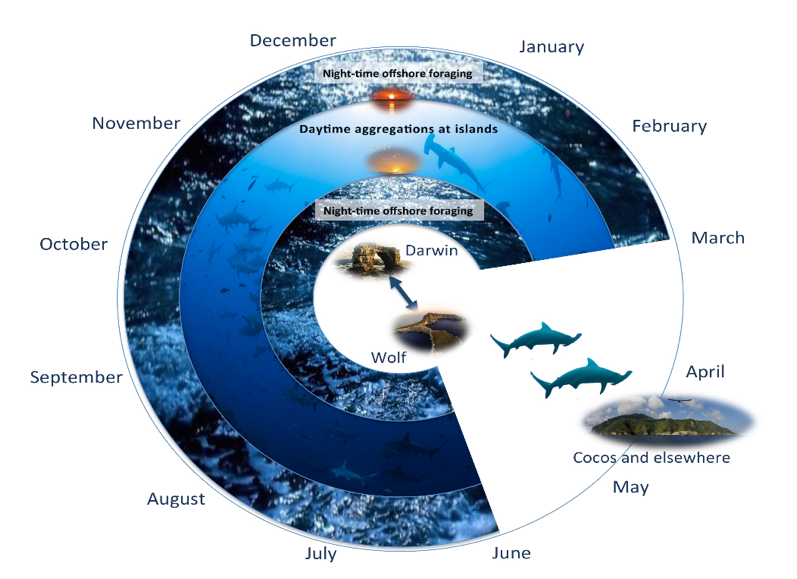The Galápagos Islands are one of the most famous diving destinations in the world, and for good reason. The remote northern islands of Wolf and Darwin are home to some of the largest schools of scalloped hammerhead sharks (Sphyrna lewini) found anywhere on the planet. Their gregarious nature and impressive presence make them a bucket-list encounter for divers worldwide.
But when is the best time to dive with hammerhead sharks in the Galápagos? Scientific studies, including extensive research by marine biologists using telemetry and visual census methods, provide clear insights into the seasonal patterns of these incredible predators.
This article is based on scientific studies:
Hammerhead Shark Season in the Galápagos
Summary
- Cold Season (June–October): The highest concentration of hammerhead sharks occurs in the Galapagos Marine Reserve (GMR), particularly around Darwin and Wolf, where 90% of tracked individuals remain inside the reserve. Strong currents and nutrient-rich waters attract large schools of sharks.
- Transition Months (May & November): The presence of hammerheads in the GMR decreases, with only 65% remaining inside the reserve as individuals begin migrating toward open waters.
- Warm Season (December–April): Hammerheads spend significantly less time in the GMR, with only 30% of tracked sharks staying within protected waters. They likely migrate beyond the reserve, increasing their vulnerability to fishing pressures.
Cold Season (June – October): The Best Time for Massive Schools
The cold season (June to October) is the optimal time to see large schools of hammerhead sharks in the Galápagos. During this period, strong ocean currents from the Humboldt Current bring in nutrient-rich, cooler waters (16°C–24°C / 60°F–75°F), which attract an abundance of marine life—including the hammerheads’ preferred prey.
📍 Where to Dive:
- Wolf & Darwin Islands – The primary aggregation sites, with recorded sightings of over 100 hammerheads per dive hour.
- Roca Redonda – A secondary site where hammerheads are also frequently observed.
📊 Scientific Findings:
According to Peñaherrera-Palma et al. (2016), during the cold season, 90% of hammerhead sharks' recorded movements remain within the Galápagos Marine Reserve (GMR), particularly concentrated around Wolf and Darwin. This means divers have the highest chance of sightings during this period.
🔹 Why is this the best season?
- Schools of hundreds of hammerheads form near Wolf & Darwin.
- Strong upwelling currents bring in abundant prey.
- Peak biodiversity—you’re also likely to encounter whale sharks, Galápagos sharks, and silky sharks in the same dives.
Transition Season (May & November): Unpredictable but Promising
The months of May and November serve as transitional periods between the cold and hot seasons. Hammerhead shark sightings can still be frequent, but their numbers fluctuate as some individuals begin to migrate beyond the marine reserve.
📍 Where to Dive:
- Wolf & Darwin Islands – Still reliable for hammerheads but with less density than in peak season.
📊 Scientific Findings:
- During the transition months, the time hammerhead sharks spend inside the Galápagos Marine Reserve drops to about 65% as more individuals begin migrating away. Sightings are still possible but less predictable than during the cold season.
🔹 Is it worth diving in these months?
- Yes, but expect smaller schools and the possibility of sharks migrating beyond the reserve.
Hot Season (December – April): Fewer Hammerheads but Still Possible
During the hot season (December – April), hammerhead sharks migrate away from the Galápagos, spending less time within the marine reserve. Warmer water temperatures (24°C–27°C / 75°F–81°F) and weaker currents lead to lower hammerhead shark densities at Wolf & Darwin.
📍 Where to Dive:
- Wolf & Darwin Islands – Still the best option, but expect fewer sightings.
- Other sites like Floreana, North Seymour, and Genovesa might see occasional individuals.
📊 Scientific Findings:
- Telemetry tracking from Peñaherrera-Palma (2016) shows that hammerhead sharks spend only 30% of their time inside the Galápagos Marine Reserve during this period. Their migration patterns shift, making sightings much rarer than in the cold season.
🔹 Should you dive for hammerheads in this season?
- If your main goal is diving with large schools of hammerhead sharks, the hot season is not ideal. However, you might still encounter individuals at Wolf & Darwin. If possible avoid March - May as the numbers drop dramatically during those months.
Why Are the Galápagos Islands One of the Best Places for Hammerhead Shark Diving?
Several factors make the Galápagos one of the top destinations in the world to see hammerhead sharks:
✔ Massive Schools – Few places offer hundreds of hammerheads in a single dive.
✔ High Year-Round Chances – Even during the hot season, encounters are still possible.
✔ Strict Conservation – The Galápagos Marine Reserve protects sharks from fishing threats.
✔ Scientific Significance – Studies show that pregnant female hammerheads frequent the region, making it crucial for their lifecycle.
According to Peñaherrera-Palma et al. (2016), historical aggregation sites beyond Wolf & Darwin (e.g., Floreana, Genovesa) are showing early signs of recovery, meaning new dive sites might become important in the future.
Choosing a Responsible Operator for Hammerhead Shark Diving
Since hammerhead sharks are critically endangered, it is important to choose a responsible dive operator that prioritizes conservation. Sustainable operators follow strict regulations that ensure shark behavior remains natural and that divers do not cause stress or harm.
🔹 What to Look for in a Responsible Dive Operator:
- Respects Marine Park Regulations – No touching, feeding, or disturbing sharks.
- Supports Conservation – Works with research groups and contributes to marine protection.
- Uses Ethical Diving Practices – Small group sizes, eco-friendly policies, and proper diver training.
- At Galápagos Shark Diving, all expeditions are focused on conservation. Our Citizen Science Expeditions allow divers to contribute to real research by recording data, capturing ID photos, and supporting the Galápagos Whale Shark Project.
Conclusion: When to Dive for the Best Hammerhead Shark Experience
For the ultimate hammerhead shark diving experience, plan your trip between June and October when the largest schools aggregate around Wolf and Darwin Islands. While sightings are possible in other months, the cold season is by far the best time to witness these majestic predators in large numbers.
If you’re passionate about shark conservation, consider joining a Citizen Science Expedition with Galapagos Shark Diving. Not only will you have the chance to dive with hammerheads, but you’ll also contribute to vital marine research and conservation efforts.
📩 For more details, visit https://www.galapagossharkdiving.com/en/galapagos-dive-liveaboard/
📧 Contact us at: info@galapagossharkdiving.com
















Write a comment